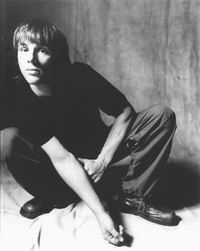He's a futuristic folkie, a techno troubadour, a music man-machine for the new millennium, equally adept at a stark heart-wrenching ballad, a shimmering soundscape or a crunchy, industrial rocker. With Columbia Records debut, Words For Living, post-modern renaissance man P.J. Olsson takes us on an aural journey through the world inside his head, an intoxicating blend of classic-rock and electronic pop splashed onto a canvas that mixes experimental found sounds with memorable melodies, catchy choruses and surrealistic wordplay.
There's Olsson's homage to hemp, Visine," the musical equivalent of a bong hit, with its pot-fueled sensual imagery ("The ozone/Like a clit/Dripping sunshine/On my lips now"), pro-pot-paganda and hilarious lyrics about "Joseph Stalin's son hauling out of Moscow in a jellybean with wheels, " topped by Olsson's operatic falsetto nod to the joys of innocence. "Ready For A Fall," featured on Columbia's best-selling Songs From Dawson's Creek, shows the other side of the singer-songwriter, with its acoustic plaint about a relationship that's too good to be true. The psychedelic "Dandelion" -- co-penned with Forest For The Trees' Carl Stephenson (who co-wrote "Loser" with Beck) -- takes a trip-hop, post-industrial blues approach as it looks through the eyes of a child, with an eerie, hymn-like orchestral backdrop that hints at the ecclesiastical as it stimulates in the senses.
P.J. Olsson is one conflicted dude and Words For Living allows his contrasting emotions full sway. "I can really escape into my music," he says. "And that's pretty much what I want to do with my life. I feel like it allows me to know myself better. It's like therapy."
Growing up in a small northern Michigan town on Lake Superior near the Canadian border, P.J. Olsson was surrounded by musical creativity. His father was an avant-garde composer in the experimental 12-tone method and an A&R executive for Motown Records while his mother majored in music and voice. "I was brought up with a sense of morals," he recalls. "Respect for my mother was the utmost and highest ideal. And then respect for everyone else. The second thing was developing your mind."
Olsson studied classical violin from the time he was five until he was 17, when his father took the family to live in Germany. While there, P.J. wrote and recorded an album (that never came out) for a small German label. In his late teens and early 20s, he became obsessed with studio production, creating tapes of hip-hop beats mixed with Middle Eastern and Native American sounds he'd sing over. After moving to Los Angeles six years ago, he released an album under the name "Dust" on the tiny Chicago Hit It Recordings label, then began recording an album for the influential German techno label Eye Q. His name began to get around in electronic/techno circles, but Olsson admits it wasn't until he picked up an acoustic guitar four years ago that he began to write real songs. "I wasn't a real good guitar player, so it forced me to keep the songs simple, which turned out to be really good for my music," says P.J.
Playing out solo and with a few trusted musicians, Olsson began to attract the interest of record companies. His gut told him to sign with Columbia Records. Olsson began a year of touring with the likes of Rufus Wainwright, Beth Orton, DJ Spooky and Placebo, pressing the flesh with radio and press and honing his music in the studio alongside collaborators like Jaime Canidiloro (Daniel Lanois' engineer on Luscious Jackson) and Keith Forsey, who co-produced the new record's title track. An eight-song mini-album, including original versions of "Visine," "Pray I Don't Die," and "Thorazine," came out in 1998 on the Red Ink label through Columbia's sister distributor RED. Critical raves from press including the Boston Phoenix (who called Olsson's songs "among the finest examples of new millennial pop") and alternative airplay set the stage for P.J. Olsson's major label debut.
"The experience was great. I was left alone for the most part," says Olsson. "There was a pretty lively give-and-take. I trust the marketing instincts of record people because I think they know how to do it way better than any artist."
Words For Living is more than just music, it is about the world around us. "Pray I Don't Die" is a dance-rocker that takes the classical dilemma of "to be or not to be" and answers in the affirmative, with crunchy rock & roll guitars set against scratchy drum loops. "Thorazine" is a wasted, technopop, love-hate ode to L.A. ("Love is my Thorazine/Lithium hell and handcream") in which Olsson wonders about his own sexual identity. "I Am The Sun" is a buoyant Who-like anthem about egomania and paranoia in the City of Angels while "Good Dream," opens the album with a frenetic and ebullient electro-acoustic rollercoaster ride through the kaleidoscopic psyche of the singer.
If you can imagine Beck, Tom Waits, Pink Floyd, the "Strawberry Fields Forever" Beatles, Trans-era Neil Young and Al Green doing "Tech Me To The River," then you begin to get a handle where P.J. Olsson is coming from. Or maybe not, as the case may be.
"When people start loving something so much they live it and become a part of it... that's what I'm enamored of," says P.J. Olsson. "I'd love to make that kind of connection with an audience." With Words For Living, he's well on his way.
